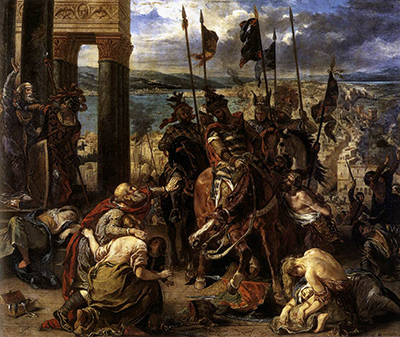In 1838 King Louis Philippe commissioned from Delacroix a large oil painting depicting The Entry of the Crusaders into Constantinople.
Delacroix took two years to deliver it, and exhibited it at the 1841 Salon to mixed reviews, with some critics admiring the freedom of his handling, while others found it overdone.
The Fourth Crusade set out to liberate the Holy Land and the city of Jerusalem from Muslim occupation, but instead found the Byzantine capital Constantinople an easier target, and pillaged it.
Given the fact that this was a royal commission, and the Crusade was largely French backed, you might expect an upbeat picture showing the Crusaders' victory.
Instead, Delacroix' sympathies appear to be on the side of the losers; as in earlier paintings like The Massacre at Chios, he dwells on the misfortunes of the victims of war, here shown begging for mercy as the Crusaders ride into the city.
The Crusaders' plumed and decorated helmets make a strong and interesting accent against the sky, but their faces are in shadow, perhaps a symbol of their guilt.
As in his picture of Sardanapalus' funeral pyre, Delacroix paints the female victims very sensually; he combined opulent exoticism, sensuality, and death, in a way that's typically Romantic but not perhaps in the best of taste.
He also paints the horses with his typical interest in their natural wildness and energy.
What lifts the painting out of banality is the landscape behind, a perspective that almost suggests an aerial view of the city of Constantinople, the Golden Horn and the Bosphorus, and the striking colours of the blue sky and sea.
These provide a bright clear background to a cluttered and rather shadowy scene; is Delacroix saying something about the contrast between nature's glory and man's shame?




